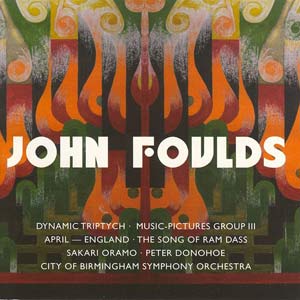John FOULDS (1880-1939)
Music composed by John Foulds
Dynamic Triptych for piano and orchestra Op. 88 (1927-29) [25:38]
April - England (Impressions of Time and Place No. 1) for orchestra Op. 48 No. 1 (1926 orch. 1932) [7:56]
Music-Pictures Group III op. 33 (1912) [19:06]
The Song of Ram Dass (1935) [3:13]
Keltic Lament Op. 29 No. 2 (Keltic Suite) (1911) [4:38]
Performed by Peter Donohoe (piano) and The City of Birmingham Symphony Orchestra
Conducted by Sakari Oramo
Recorded at Symphony Hall, Birmingham, 11, 13, 15-16 Jan 2006. DDD
Available on Warner Classics (2564 62999-2)
Running Time: 61:05
Crotchet Amazon UK

See also:
John Foulds - Three Mantras from Avatara Warner Classics and CBSO conductor, Sakari Oramo, are to be congratulated on this the second volume in their new series of recordings of the colourful but seriously undervalued and neglected British composer John Foulds. [The first volume, issued in 2004, Warner Classics 2564 515252, included Three Mantras from Avatara, and is linked above.] Considering the power and accessibility of his music the neglect is incomprehensible. It is so cinematic.
John Foulds lived from 1880-1939 so only his last few years spanned the beginnings of the original film score pioneered by Max Steiner in the 1930s. But had he lived on perhaps he would have been attracted to film as a medium of expression and equally had Hollywood (or, of course, British film producers) become acquainted with his craft, I feel sure they would have snapped his talent up.
The extraordinary artwork on the cover of this album’s booklet hints at the equally extraordinary music. This artwork, untitled, is by John Patrick Foulds, the composer’s son who described the colourful Foulds household thus: "my sense of smell was early stimulated by roses, oil paint, batik wax smoking and joss sticks burning on ‘The shrine’". He goes on to relate that his mother (Maud McCarthy) and Foulds had ‘reached Theosophy’ from quite opposite family backgrounds: she from being an Irish Catholic, and he Plymouth Brethren. ‘She moved via Plato, Ruskin and Morris to a studious eclecticism; he in search of ever deeper meaning through his interpretative, then creative and innovative music.
His style embraced, as well as accepted Classical and Late Romantic styles, Far and Middle Eastern modes, syncopated Gershwin-like jazz rhythms, extraordinary dissonances and glissandi; and other unusual musical forms. He wrote ahead of his time, yet his music is eminently listenable.
John Foulds’s Dynamic Triptych for piano and orchestra was composed in 1927-29 It is of course, to all intents and purposes, a piano concerto conceived in the grand Late Romantic manner. And dynamic it is. The opening movement, ‘Dynamic Mode’ incorporates all the features outlined above. Its great climaxes heard in the first movement and elsewhere would fit perfectly into any screen epic drama or adventure. The second ‘Dynamic Timbre’ movement is so melodic and atmospheric; themes of nobility and an appealing romantic tenderness contrast with dread, even creepy material. Even pre-echoes of Bernard Herrmann are discernible. The third ‘Dynamic Rhythm’ movement echoes Gershwin.
The other major work in this adventurous programme is Music-Pictures Group III, which created quite a sensation at its Promenade Concert Premiere in 1912. The very title suggests vivid cinematic-like evocations. The ‘music pictures’ were designed to reflect, in sound, Foulds’ reactions to specific paintings. ‘The Ancient of Days’ is a sound portrait after the famous Blake painting depicting God as an architect measuring chaos with a pair of dividers. Foulds’ impression is a processional, scored for an orchestra without strings; it proceeds in sombre and thunderous majesty. ‘Colombine’ follows Alfred Brunet’s painting that had so impressed Foulds at the Paris Salon of 1906. This time the music is all joy and grace and fleeting lightness, but with some extraordinary glissandi suggesting one or two passing shadows across sunlit glades. ‘Old Greek Legend’ is a beautiful elegy suggesting classical columns and dignified, ancient Greek figures gradually becoming more and more animated. The music at this point is very reminiscent of Elgar, and it was inspired by a sketch by the Victorian painter, John Martin. The final painting in the group by Paul-Ēmile Boutigny, depicts a medieval town in uproar, roused by an alarm bell (‘The Tocsin’). All the chaos is excitingly and colourfully realised by Foulds’s music that vividly conjures up not only the turmoil (and the pathos in its wake) but also the time and place of its occurrence. Think Richard Strauss and Til Eulenspiegel and you will have some idea of this music.
The Song of Ram Dass is a beautiful and seemingly realistic evocation written in the Indian style. It is extraordinary how alike this material is to the sound world of Miklós Rózsa’s epics, yet it was written in 1935 shortly after Foulds arrived in the India. Equally redolent of the “Scottish-Celtic” vein, is the plangent melody that is Foulds’ Keltic Lament. It is noble grief not too far removed from the mood of Horner’s lovely theme from his Legends of the Fall score. Horner’s Legends of the Fall music (at about 3:30) also came to mind when I was listening to April-England (Impressions of Time and Place No. 1) i.e. - in the middle section that seems to speak with pride and affection of England. Elsewhere this is an opulent evocation of the burgeoning of Spring with profusion of blooms and birdsong.
Very strongly recommended. Accessible, cinematic music; thrilling and vividly coloured.
Ian Lace
Rating:
5
Return to Reviews Index